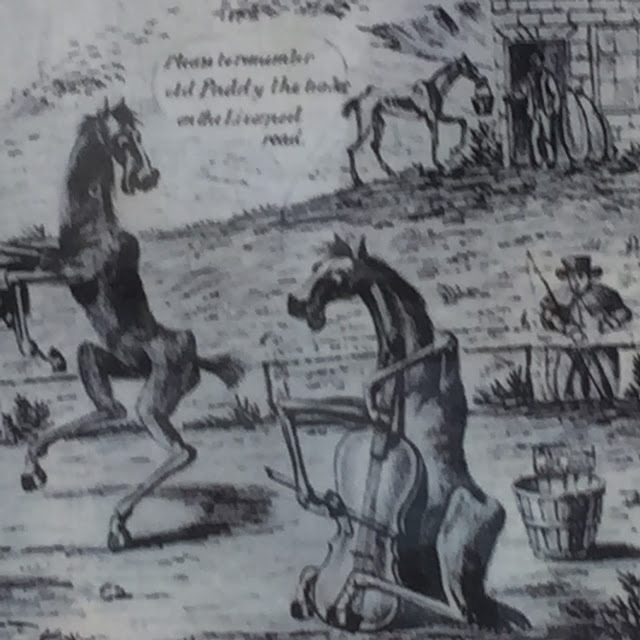Haywards Heath III
With railroad plans for Haywards Heath came concern for stagecoach horses put out to grass as in this Victorian cartoon displayed in Cuckfield Museum. The smell of horse dung gave way to the smoke smell and sound across the adjacent Heath when our railway opened 12 July 1841.
Conway Gabe and Wyn Ford’s ‘The Metropolis of Mid Sussex - A History of Haywards Heath’ was published 1981. It’s no light read as ‘magnum opus’ on our town despite its bright cover, section of the colourful 1638 ‘survae of the land belonging unto Nicholas Hardham’. There’s an invaluable tracing of the 1638 map over the 1981 map with 19 stars denoting where part or all of the original buildings still exist - or did in 1981!
Conway Gabe and Wyn Ford’s ‘The Metropolis of Mid Sussex - A History of Haywards Heath’ was published 1981. It’s no light read as ‘magnum opus’ on our town despite its bright cover, section of the colourful 1638 ‘survae of the land belonging unto Nicholas Hardham’. There’s an invaluable tracing of the 1638 map over the 1981 map with 19 stars denoting where part or all of the original buildings still exist - or did in 1981!
Wishing you good luck from Haywards Heath! It’s not as green nowadays in Bents Wood where Anne and I live. I’m grateful to my friend Charles Tucker for this copy from his postcard collection which covers the town’s evolution over a century or more. Who can date this picture? The cars on South Road are the main clue.
Anyone recognise the fisherman? Yes, you could fish in Haywards Heath in the 1960s, until Bridgers Mill pond was drained. The diesel train above helps date this photo from Charles Tucker’s collection. Today Balcombe Road goes over the filled pond as it passes into College Road through the railway bridge. There’s a grass triangle where the fisherman stands. Lacey’s is the shop visible through the bridge. The Mill on the right is now offices.
I live in Bentswood which can justly be called the oldest part of Haywards Heath due to Quaker philanthropist William Allen (1770-1843) visiting Lindfield in 1821 ‘the poorest, most neglected village he had ever seen’. He built these wattle and daub cottages in Gravelye Lane to be rented with land for crops by Lindfield’s poor as part of the ‘American Colony’. The cottages shown in Charles Tucker’s postcard, built years before the railway, are now demolished.
How sad to see Sussex greenery laid bare for the railway! Yet where would Haywards Heath be without it? This picture from Charles Tucker and Philip Ladd - half green, half brown - captures a local scene in the years approaching 1841. Green fields are turned brown by the new railway which today serves to make Brighton ‘London-by-sea’ and London ‘Brighton-inland’!
Awesome scene from 1937 on the spot I park my car day by day when I go to St Richard, Haywards Heath on Sydney Road. I park by the foundation stone being blessed here by the Bishop of Lewes seen here in his mitre. The photograph shows white bearded Fr Wyatt (83) who as second parish priest at St Wilfrid’s helped achieve the new build along with St Richard’s first priest-in-charge, Fr Wylie who is standing behind him.
Heath Theatre was Haywards Heath’s first cinema. It was built on The Broadway over a century ago in 1911. In those days The Broadway was taking over from Boltro Road on the other side of the railway as commercial centre. Heath Theatre had an upper circle and seated 400. In 1936 the Perrymount Cinema and dance hall was built at the top of Perrymount Lane and its greater capacity made for the eclipse of Heath Theatre. The building was redesigned and became a gas showroom then a restaurant and newsagent Today it’s Côte Brasserie alongside Pizza Hut. The new design included a spire which still catches the eye down Broadway.
Can you imagine when planes were novelties? Haywards Heath was at the cradle of aviation through pioneer Gordon England who lived with his parents at Oakwood. Ford & Gabe’s ‘Metropolis of Mid Sussex’ describes how in May 1911 Gordon and Oscar Morison ‘were the occupants of a Bristol biplane which made a forced landing at Freaks Farm near Burgess Hill because of a petrol shortage. Next day Mr Morison was piloting a biplane over Haywards Heath when it became entangled in a tree at Oakwood’. This picture from Charles Tucker captures local excitement.
These smartly arrayed Haywards Heath firemen pose in 1926 outside their station on South Road just east of Victoria Park built 1904 but now demolished. The line of shops and offices next to the park stand on the site which belonged to the old Urban District Council. Prior to 1904 fire services operated from The Yews at Muster Green nearer to our mother community of Cuckfield. In the 1960s fire services moved to their current home on Mill Green Road previously occupied by the gas works. This picture is from Charles Tucker.










I have vivid memories of The Perrymount Cinema in the mid to late 1950s. I was a projectionist at this cinema. There were three projectionists Myself Ray Roberts . Bernard Addison And Roy Hog who was the Chief Projectionist.
ReplyDeleteThe projector Arc Lamps were Powered by a Petter Diesel which required lots of TLC.